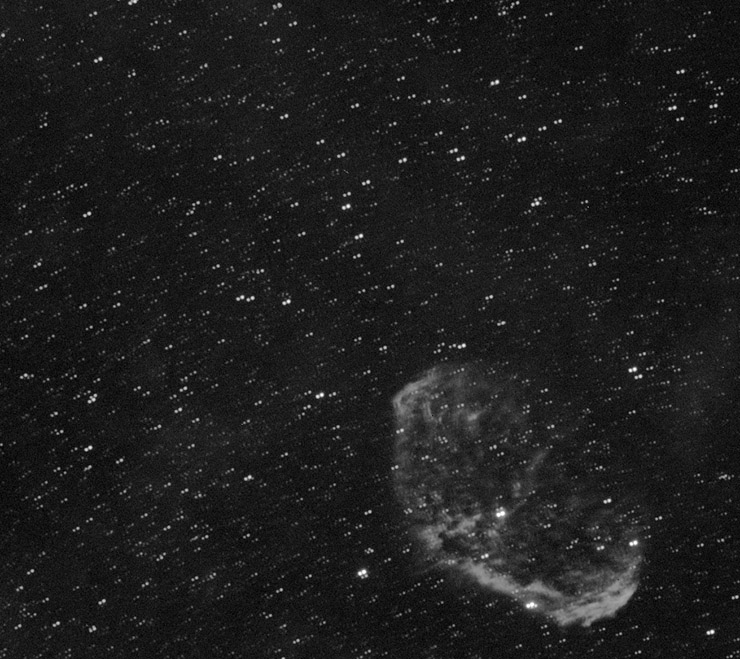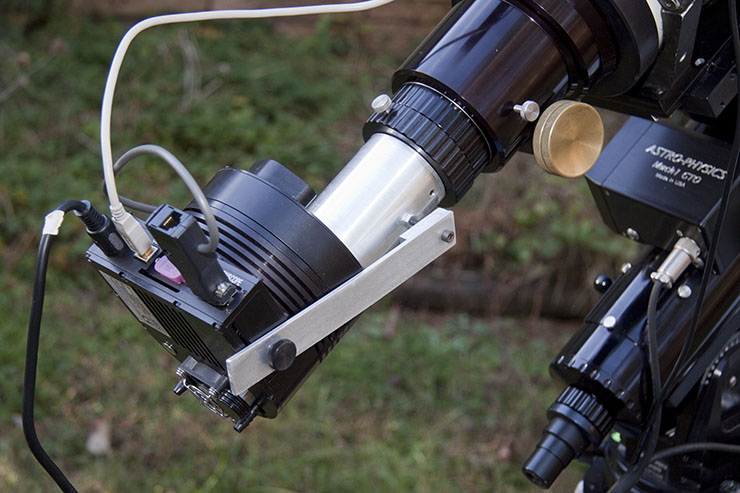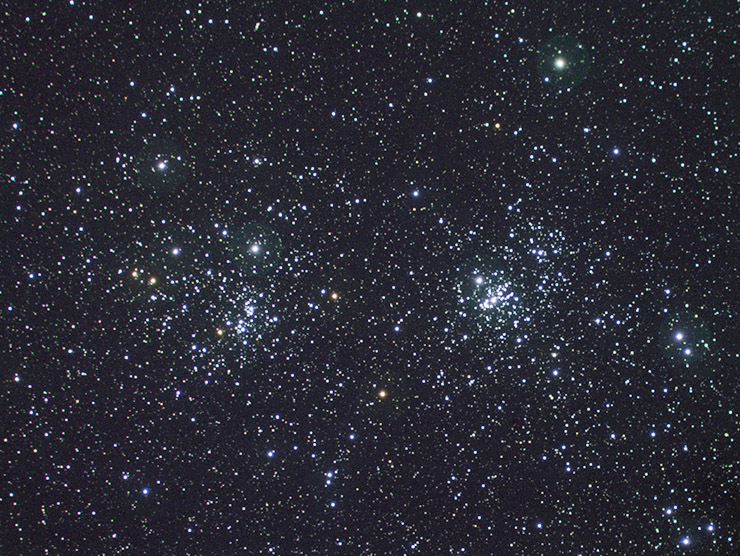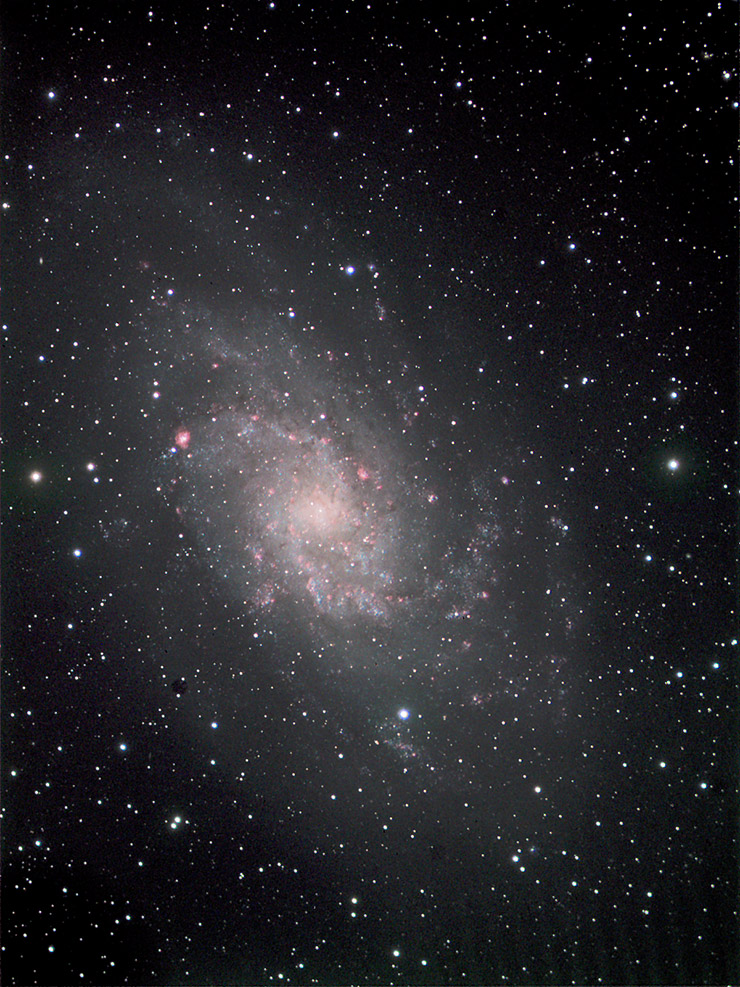The Starry Night, 30 :: home :: |
|
11/13/2010: Combining H-a with RGB turns out to be a snap. As much as anything in this sport is. Instead of overlaying it on a finished RGB image (a technique which also has its place), substitute it for the R channel. That is, instead of RGB, do HaGB. Here's a demo from last night. See:
NGC 6888, the Crescent Nebula in Cygnus
Of course, there's lot of rebalancing among the channels to do in order to get plausible star colors. That, for example, is 3:1:1 and there's lot of room to experiment. Not bad with a half Moon sharing the same part of the sky, no? I would have gone a little longer in H-a, but I discovered a fault with the imaging rig. Using rubber bands to hold the CCD in a fixed orientation against unwanted slack in the imaging train just doesn't cut it. See:
In the middle of the 4th 15-minute sub-exposure of the Cresent Nebula, as the telescope followed it down the western sky, lifting the CCD higher, the weight of the cables changed enough to cause the camera to rotate and take up the slack between the registration pin of the Mandel Nikon F-mount faceplate and the T-ring that holds the 2-inch prime-focus adapter (the slot in the T-ring into which the indexing pin clicks is too wide). It's not a lot of play in the ordinary scheme of things, but it's a gross shift when dealing in microns everywhere else. So today I puzzled over and manufactured a FOBES device (that's Fixed Orientation Brace for Electronic Sensors). It's a piece of thin aluminum bar stock cut and drilled to match the spacing between the camera's 1/4x20 mount and the 10-24 bolt that locks the prime focus adapter into the rigid spacer I long ago machined to optimize the use of the telecompressor. Nothing moves now:
(Note: I'd like to route the cables through the cable bracket I made to attach to the guide-scope so that their weights and tensions change less and apply only at that central point -- and I do, most of them. The power cord on the CCD is too short for that solution. I could also use J.B.Weld to make a new registration hole in the T-ring. But the odds of ruining it rather than repairing it look pretty good from here.) So, does the new brace work? Check out these 10 consecutive 15 minute exposures:
The Veil Nebula, a supernova remnant in
Cygnus
After the camera shifted last night, I saw little point in shooting another two frames of H-a, as planned, since aligning the data would be a chore. Instead, I killed some time with a quick look at M15. I was really waiting for the Double Cluster to clear the treetops to do a with- and without comparison of the Baader fringe-killer filter. Here's a quick look at M15, a very different globular cluster from M3 and M13:
M15, globular cluster in Pegasus
I shot this in RGB and L but I am having some trouble getting a good combination. I think the Fringe Killer does a great job tightening L, but I think it is playing hell with the color balance among the RGB channels. So here's a five minute "snapshot" in L alone. I shot the Double Cluster using the same settings as last night, 300 second exposures in RG and B, 3 of each rather than 12 of each, thank you very much, but with the Fringe Killer filter in place. I lost two of the green subs to the same shift shown above with NGC 6888. Here's a combination of one set of 300s subs to allow direct comparison to the similar exposure last night:
The Double Cluster in Perseus I can't seem to shake that slightly sickly green hue amongst the brighter stars. The stars are definitely tighter. Maybe with a careful recalibration of the filters the Fringe Killer would be a resounding success, but if I'm going to go to that much trouble, there are other adjustments I'd like to make first (like maybe using anti-reflection coated filters to lose the bright green halos that I am now removing in Photoshop). I had intended to call it a night after the Double Cluster test, but the Milky Way was clear, the sky darker than average, and the stars steady. It was simply too good a night to waste. I decided to slew to M33 and try a frame. The luminance image was noticeably crisper than yesterday's. Score one for the Fringe Killer. I did a series of 900s exposures, mostly L, finishing with a single set of 900s RGB's. To the finished LRGB, I overlaid the H-a frame from a couple of nights ago. Nice, no?
M33, the Pinwheel Galaxy in Triangulum
That's a grand total of 6 hours of exposure. Most of the images on this page were exposed on 11/12 and processed 11/13. Today (11/13), there are finally some clouds in the sky. Maybe it will be clear enough to get in a short run on something to make sure the camera brace has no unexpected faults (see the Veil image above!), but all in all a few rainy days will let me catch up on sleep and reprocess last week's take at leisure. |
:: top ::
© 2010, David Cortner






